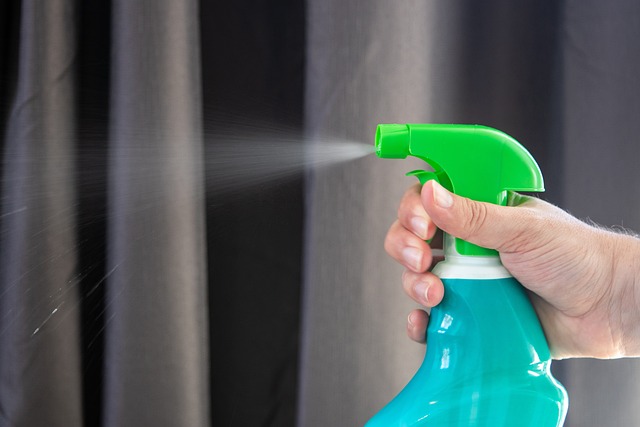
In the quest for a clean and healthy home, the power of nature shines brightly through DIY Natural Disinfectant Sprays. Harnessing the essence of essential oils, these homemade solutions offer a compelling alternative to commercial disinfectants laden with chemicals. In this guide, we embark on a journey into the world of do-it-yourself cleaning, where simplicity meets efficacy. Essential oils, derived from plants, become our allies in crafting sprays that not only sanitize but also bring refreshing aromas to our living spaces.
These concentrated extracts from plants like tea tree, lavender, lemon, eucalyptus, and peppermint hold natural antimicrobial properties, making them potent allies against germs. We’ll unravel the secrets of creating personalized DIY disinfectant spray recipes, from all-purpose cleansers to linen sprays, ensuring a healthier home environment. With an emphasis on safety, simplicity, and environmentally conscious practices, this guide empowers you to transform your cleaning routine into a fragrant and effective journey, where the power of essential oils becomes the cornerstone of a naturally clean home.
See also our post on The Power of Essential Oils in Aromatherapy Cleaning
What to Understand About Essential Oils
The Basics of Essential Oils
Essential oils are concentrated plant extracts, each carrying unique properties and scents. From tea tree oil’s antibacterial prowess to the uplifting aroma of citrus oils, understanding the basics allows you to tailor your DIY disinfectant spray to your preferences and cleaning needs.
Antimicrobial Properties
Essential oils possess natural antimicrobial properties, making them effective against bacteria, viruses, and fungi. Delve into the specific oils renowned for their disinfecting abilities, such as eucalyptus, lavender, and peppermint, to create a well-rounded cleaning arsenal.
Benefits of Natural Disinfectants
Choosing natural disinfectants contributes to a healthier living environment. Unlike commercial options laden with chemicals, DIY solutions harness the power of nature, providing effective disinfection without compromising indoor air quality or introducing harmful residues.
Essential Oil Safety Considerations
While powerful, essential oils require careful handling. Familiarize yourself with safety considerations, including proper dilution ratios, potential allergens, and safe usage around pets and children, ensuring a positive and risk-free DIY experience.
Selecting Quality Essential Oils
Quality matters when it comes to essential oils. Opt for reputable brands that provide pure, therapeutic-grade oils. Understanding the sourcing, extraction methods, and testing procedures ensures you harness the full potential of these aromatic wonders.
Essential Oils for DIY Disinfectant Sprays
1. Tea Tree Oil (Melaleuca)
Tea tree oil is a disinfectant powerhouse with broad-spectrum antimicrobial properties. Ideal for combating bacteria, viruses, and fungi, it serves as a foundation for many DIY disinfectant spray recipes.
2. Lavender Oil
Lavender oil not only adds a pleasant fragrance but also boasts antibacterial and antiviral properties. Its calming aroma enhances the overall cleaning experience, making it a versatile addition to DIY disinfectant blends.
3. Lemon Oil
Lemon oil’s fresh and uplifting scent is complemented by its potent antibacterial and antiviral characteristics. Incorporating lemon oil into your DIY spray not only cleans but also imparts a refreshing aroma to your surroundings.
4. Eucalyptus Oil
Renowned for its respiratory benefits, eucalyptus oil brings powerful antiviral and antibacterial properties to your DIY disinfectant. It’s particularly useful during cold and flu seasons for maintaining a healthy home environment.
5. Peppermint Oil
Peppermint oil adds a minty freshness to your DIY spray while contributing antibacterial and antiviral properties. Its invigorating scent enhances the overall effectiveness of your homemade disinfectant.
See also our post on Healthcare Facility Disinfection: Protecting Patients and Staff
DIY Disinfectant Spray Recipes
All-Purpose Disinfectant Spray
Combine white vinegar, distilled water, and tea tree, lavender, and lemon oils to make a multipurpose disinfectant that may be used for any purpose. You can change the ratios to suit your needs and preferences.
Fresh Citrus Surface Spray
Blend lemon oil, grapefruit oil, and eucalyptus oil to fill your house with the fresh perfume of citrus. This colorful mixture not only cleans surfaces but also leaves a pleasant aroma behind.
Calming Lavender Linen Spray
Create a relaxing linen spray by combining lavender and chamomile oils. Mist pillows, bed linens, or curtains to create a tranquil environment that encourages unwinding and guarantees a restful night’s sleep.
Invigorating Mint Bathroom Spray
Use peppermint, eucalyptus, and tea tree oils to create a strong blend that combats bacteria and leaves your bathroom feeling minty fresh. This will up the ante on your bathroom cleaning regimen.
Disinfectant Wipes
Increase the effectiveness of homemade natural disinfectants by using them on wipes. To make a handy, portable disinfectant that is ideal for surfaces and regularly touched objects, soak cloth wipes in a solution of tea tree oil, lemon oil, and water.
Application and Usage Tips
Proper Surface Disinfection
Ensure effective disinfection by following proper application techniques. Thoroughly clean surfaces before spraying your DIY solution, allowing it to sit for a few minutes before wiping away for optimal germ-fighting action.
Regular Cleaning Routine
Incorporate DIY natural disinfectant sprays into your regular cleaning routine. Consistency is key to maintaining a healthy home environment, preventing the buildup of germs and ensuring a clean living space.
Safe Usage Around Pets and Children
Exercise caution when using essential oils around pets and children. Keep the area well-ventilated, opt for pet-safe oils, and use lower concentrations to minimize potential risks. When in doubt, consult with a veterinarian or pediatrician.
Storage and Shelf Life
Store your DIY disinfectant sprays in dark glass bottles to protect the essential oils from light degradation. Keep them in a cool, dark place, and be mindful of the shelf life of your concoctions, refreshing them periodically for optimal efficacy.
Testing on Small Areas
Before widespread use, test your DIY disinfectant spray on a small, inconspicuous area to ensure compatibility with different surfaces. This precaution prevents potential damage and allows you to refine your recipe if needed.
See also our post on Tips for Cleaning and Disinfecting Your Car’s Steering Wheel: Safe Driving
Environmentally Friendly Disinfecting
Eco-Friendly Packaging
Reduce environmental impact by choosing eco-friendly packaging for your DIY disinfectant sprays. Opt for reusable or recyclable containers to align with sustainability principles and minimize single-use plastic waste.
DIY Refill Stations
Establish DIY refill stations for your disinfectant sprays. This eco-conscious approach reduces packaging waste and allows you to customize your blends based on evolving cleaning needs.
Water Conservation
Practice water conservation when crafting and using DIY disinfectants. Use distilled water sparingly, and consider collecting rainwater for your formulations to minimize the environmental footprint of your cleaning routine.
Composting Citrus Peels
If your recipes include citrus oils, compost the leftover peels. This sustainable practice not only reduces waste but also enriches your compost with natural oils, benefiting your garden and the environment.
Responsible Essential Oil Sourcing
Choose essential oils from reputable brands committed to responsible sourcing and sustainable practices. Supporting companies that prioritize ethical and eco-friendly production contributes to a cleaner and healthier planet.
Conclusion
Using essential oils to make homemade natural disinfectant sprays gives you the ability to keep your home clean and healthy while embracing sustainability. This guide provides you with all the information you need to create a greener and cleaner living environment, from learning about essential oils to creating customized recipes and implementing eco-friendly practices. Finally, embrace the aromatic journey of natural cleaning and turn your house into a haven of freshness and wellbeing.







